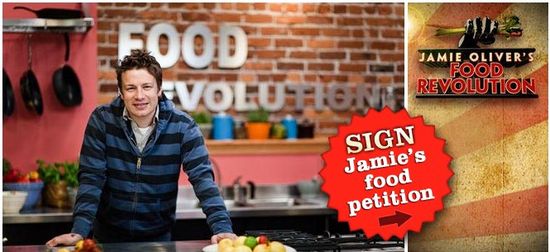I used to dream of a good marketing TV show. Not one that makes the world of marketing into a scripted drama, like Mad Men. Or one that pretends to be about business but actually ends up being about relationships and emotional conflict like The Apprentice quickly became. The Shark Tank on ABC comes close, as up-and-coming entrepreneurs try to sell their ideas for funding to a group of ruthless investors … but even that format is a bit abstract when it comes to more of the day to day reality of marketing.
Recently I've gotten hooked on an unlikely program – a reality TV show about a British chef who is trying to convert the unhealthiest city in America (Huntington, West Virginia) to be more health conscious about the food they eat. Jamie Oliver's Food Revolution is a show about a quest Jamie Oliver is on to educate America about the food we eat, the dangers of processed food and how to cook healthy. He won the TED Prize earlier this year for the idea and is now fighting his battle through a TV program on ABC.
The show has all the real life appeal that drives viewers to watch reality programs – along with the story of a man on a mission usually reserved for documentary films. Along the way, the show is rapidly becoming a brilliant case study in social marketing and how to change beliefs. The last episode which aired this past week showed Jamie making a bet with a local radio DJ in Huntington that he could get 1000 people in the city to cook healthy in 5 days. Over the first few episodes, you also saw Jamie helping school "lunch ladies" to make healthier food for schoolchildren and working with a small group of high school students on reinventing their lunch menus.
If you do any sort of cause related marketing, or have an interest in changing the world in your own way … I highly recommend watching this show. Here are a few initial marketing lessons that I'm taking away from the program over just a handful of the first episodes:
- Set an impossible goal. Jamie has already set what may be the most ambitious goal ever – to change the way the entire country of America eats. The way he initially brought it to life, though, was to focus on educating what has been called the unhealthiest city in America – Huntington, West Virginia. By choosing a seemingly unchangeable city where more than 50% of adults are obese, he created a goal that seemed unreachable. When you have a goal like that, you become an underdog and if there is one truth of human behaviour (especially in America), it is that you can't help but cheer for the underdog.
- Put in the hard time for your cause. One of the most unique things about Jamie's Revolution is that he is fully invested in the first goal of changing Huntington – spending at least two months (and perhaps longer) living and working in the city. By being there every day and understanding the community, he is able to find the right influencers who matter to help him spread his message, and (more importantly) to build some credibility as someone invested in the city rather than an outsider focused on quick results.
- Build your own evangelists. By being in the city for an extended period of time, Jamie was able to create his own groups of supporters. This was important when he launched his crusade to teach 1000 people to cook in a week because he already had people in the community who would speak on his behalf and help recruit others.
- Convert your biggest enemy. Central to his early successes was how he understood early on that converting his biggest detractor would be a necessity towards converting the rest of the city … particularly because this individual happened to be the host of the largest local radio program. So instead of focusing on those who might be more "influential" such as the Mayor or Governor, he focused on someone who could have an even bigger impact if he could change his perceptions.
- Don't count on one campaign (or focus on one demographic). This may be the most valuable lesson to take away from the program. In most cases for marketing campaigns, you choose a target audience and build a campaign around that. Jamie, on the other hand, has focused on Elementary schools, gone to a college campus to start a flash mob, ventured into people's homes to interact personally with them, and even taught a group of steel workers how to cook. By speaking to multiple groups at the same time, he is effectively building his revolution beyond just one group. Ultimately, that's what a revolution will take.
Video of the Flash Mob:







WE RECENTLY REMOVED COMMENTING - LEARN WHY HERE >